Corsican gastronomy
A rich gastronomic heritage
For your holidays on the island of beauty, at our Perla di Mare campsite in Corsica, you won’t be able to resist Corsican gastronomic products.
Come and taste Corsican gastronomy: cheese, charcuterie, wine, biscuits and many other local products to be sampled without further ado. If you’re planning a road trip in a van in Corsica, you can discover the island’s gastronomy throughout your trip as you travel through the different regions.
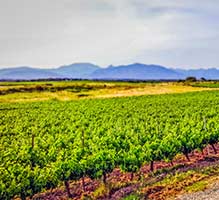
Discover Corsica’s gastronomy
With so many quality resources from land and sea, Corsican cuisine is renowned for the flavour and quality of its dishes. Today’s chefs, while inspired by traditional recipes, revisit culinary techniques with talent. You can’t really appreciate Corsican gastronomy without trying figatellu (liver sausage with fine herbs), veal with olives, lonzu (spicy pork loin), coppa (dried pork loin strips), pieces of meat grilled slowly over a wood fire. We also recommend trying Corsican soups, particularly the bouillabaisse known as ‘azziminu’, and soups made with legumes and meat. When it comes to cheeses, “brocciu”, a fresh cheese made from goat’s or sheep’s milk, is a traditional speciality that features in many of Ghisonaccia’s traditional recipes. This tasty ingredient is a real delight in aubergines à la bonifacienne, herb turnovers and chard pie.
Other quality cheeses are served as desserts or snacks. As for dishes inspired by seafood, oysters, mussels, lobster and spider crab are often served with cannelloni-type pasta with spicy sauces.
Fans of irresistible desserts will love the fiadone, chestnut and apple fritters with citron. In the restaurant, you’ll be offered typical Corsican digestifs. These, made from berries and fruit, are well worth discovering, as is the traditional ‘rappu’ (the Corsican equivalent of Italian grappa).
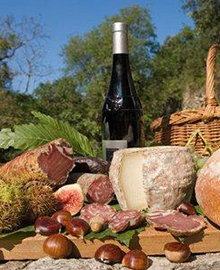

Useful notes:
If you would like a list of restaurants in Ghisonnacia, simply consult this city directory: https://www.annuaire-mairie.fr/restaurant-ghisonaccia.html. You’ll also find a detailed map of the town and a range of resources on the small town and the surrounding area.
For all administrative formalities, it is advisable to contact the Ghisonaccia town hall directly, whose offices are in Place de l’Hôtel-de-Ville.
La charcuterie Corse
Corsican charcuterie, now internationally renowned, was for a long time the sole meat-based diet of inland Corsica, when traditional cooking and curing techniques were still the only known methods of preservation. One of the most famous Corsican charcuterie specialities is Figatellu, a smoked liver-based speciality that can only be found on the island between November and April if you want a truly traditional product.
Salamu (sausage), on the other hand, is available from March to August. Panzetta, sometimes rolled, is made from dried and salted bacon. Only three Corsican charcuterie specialities have a registered designation of origin: coppa, slices of loin salted and cured for 5 months; lonzu, a leaner charcuterie made from sirloin, salted and cured for 3 months; and prisutu, a ham eaten after a year and a half of curing and maturing.
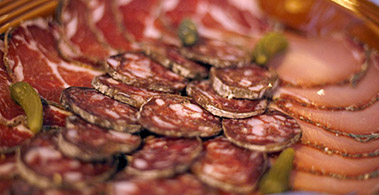
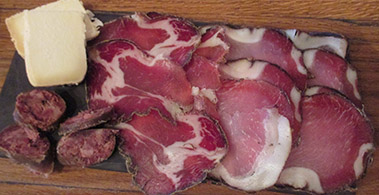
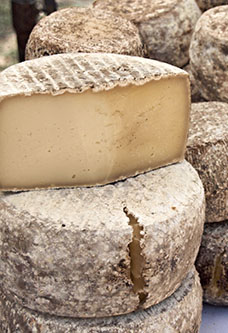
Corsican cheese
Corsican cheeses come in a wide variety all over the island, although most are made from sheep’s milk. Brocciu is the most famous because it has a registered designation of origin. Brocciu is made from whey and is highly distinctive and emblematic of the island. Its seasonal production and short shelf life make brocciu a typically Corsican product that is rarely exported. Alongside brocciu, a fresh cheese, Corsica also produces pressed and soft cheeses: sartinesi, a cylindrical cheese made from ewe’s or goat’s milk; the bastelicacciaA soft cheese with a natural rind produced exclusively on farms; The calinzanaA soft, washed-rind goat’s or sheep’s cheese that is best eaten young; the Niolumade exclusively by farm producers, and eaten mature or aged; or the Venacumade from raw goat’s or sheep’s milk, or sometimes both.
Corsican gastronomy: other local products
Olive oil: the olive tree is one of the oldest crops in Corsica. The island has a PDO Oliu di Corsica, which is distinguished by its golden colour, and by the sweetness implied by the use of very ripe olives.
Wine: vines were introduced to Corsica in the 6th century BC, when the city of Aléria was founded. The majority of Corsican AOC wines are red and rosé.
Chestnuts: emblematic of the island, the chestnut tree has been feeding Corsicans with its fruit for centuries. Known as the breadfruit tree, it is used to make flour for breads, cakes and sweet biscuits.
Honey: Corsican honey has a registered designation of origin. Its complex flavours reflect the island’ s biodiversity and its mountainous and marine character.
Sweet biscuits: these are known as canistrelli, croquets or frappe, and are an integral part of Corsican gastronomy.


To make the most of your camping holiday in Haute-Corse, discover also Porto Vecchio, Calvi, Bastia, Bonifacio, Ile-Rousse, Propriano, Aleria, Ghisonaccia, Sari Solenzara, Corsicanmountains, Corsican villages


